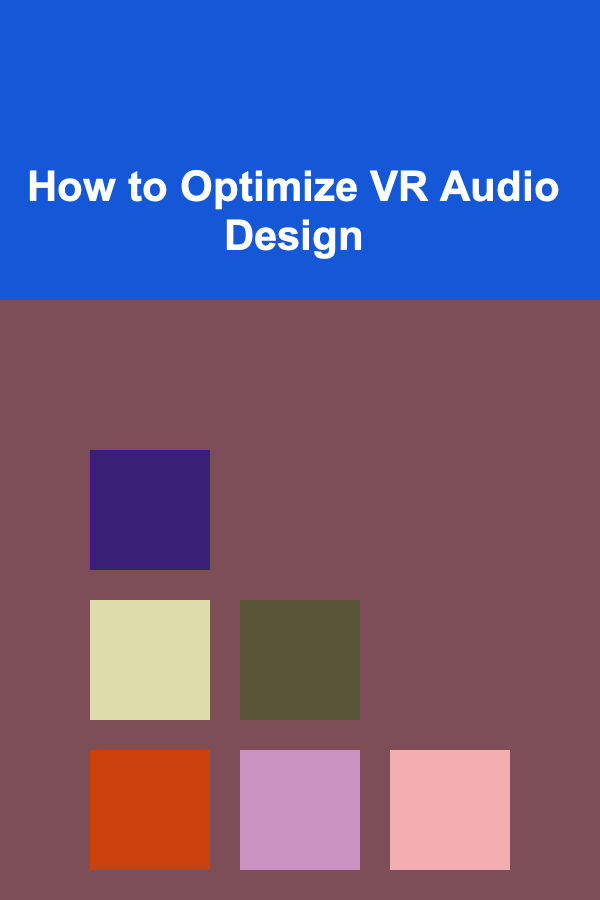
How to Optimize VR Audio Design
ebook include PDF & Audio bundle (Micro Guide)
$12.99$8.99
Limited Time Offer! Order within the next:

Virtual Reality (VR) has revolutionized the way we experience digital environments, creating immersive experiences where users can engage with virtual worlds in ways that were once the stuff of science fiction. While the visual aspect of VR gets most of the attention, the audio design is equally crucial in creating a truly immersive experience. Poor audio design can break the illusion of presence, making the virtual world feel flat or disconnected from the actions within it. Optimizing VR audio design is therefore essential to achieve a fully immersive, believable, and interactive VR experience.
This article will explore how to optimize VR audio design, covering key aspects such as spatial audio, environmental soundscapes, dynamic audio, and the integration of audio with user interactions. By understanding and applying best practices in VR audio design, developers can significantly enhance user immersion and engagement.
The Importance of Audio in Virtual Reality
In a VR experience, users are physically immersed in a digital world. To maintain this sense of immersion, all sensory inputs must align cohesively. The visual aspect of VR is often enhanced with detailed textures, 3D models, and animations, but the audio has a significant impact as well.
The brain processes sounds and images together to create a unified perception of the environment. Discrepancies between what a user sees and hears can break the illusion of immersion. For example, if a player sees a footstep coming from their right but hears it from the left, they will immediately be pulled out of the experience. Proper audio design ensures that the user perceives the virtual world as being just as real and interactive as the physical world.
Audio serves several functions in VR:
- Spatial Awareness: Audio cues provide a sense of space, direction, and distance, allowing users to navigate and interact with the virtual environment.
- Emotional Engagement: Music, sound effects, and environmental sounds can influence the emotional tone of the experience, heightening excitement, tension, or calm.
- Feedback Mechanism: Audio serves as feedback, providing users with immediate auditory confirmation of their actions within the virtual space.
Understanding Spatial Audio
Spatial audio is the cornerstone of VR audio design. It allows users to perceive the direction and distance of sounds, which is essential for creating a realistic virtual environment. Without spatial audio, sounds would seem to come from nowhere, making the experience disorienting or artificial.
2.1 Binaural Audio and Its Role
Binaural audio is a technique that mimics how humans hear sound with two ears. The key to binaural sound lies in two primary factors: interaural time difference (ITD) and interaural level difference (ILD). ITD refers to the difference in the time it takes for a sound to reach each ear, while ILD refers to the difference in the sound's volume between the two ears. By manipulating these elements, binaural audio creates a three-dimensional sound field that users can perceive as coming from a specific direction and distance.
In VR, binaural audio is particularly powerful because it aligns with how humans naturally perceive the world. By using binaural techniques, audio designers can make users feel as though they are surrounded by sound, even in a completely synthetic environment. This increases immersion by providing cues about the virtual environment's layout, such as knowing that a monster is behind you, or that a conversation is happening to your left.
2.2 HRTF (Head-Related Transfer Function)
Head-Related Transfer Function (HRTF) is a concept that allows audio designers to simulate how the shape and position of the ears influence the sound reaching them. It takes into account the complex acoustics of the human head, pinna (outer ear), and ear canal, which modify sound waves as they travel toward the eardrum. These modifications provide important spatial information, such as the elevation and angle of a sound source.
By applying HRTF to VR audio, designers can create realistic directional sound cues, making it possible to discern whether a sound is coming from above, below, or to the side. Many VR systems, like Oculus, support HRTF for binaural audio rendering, allowing developers to deliver spatially accurate sound experiences.
2.3 3D Audio Technologies
Several 3D audio technologies exist to optimize spatial audio in VR, including:
- Ambisonics: A full-sphere surround sound technique that captures the sound environment in all directions (including up and down). Ambisonics works well in VR because it allows for accurate reproduction of sound from any direction around the user.
- Stereo Panning: This technique involves positioning sounds across the left and right stereo channels. While not as immersive as binaural or 3D audio, stereo panning can still enhance the perception of sound direction in a limited space.
2.4 Implementing Real-Time Audio Processing
In VR, the user's position and orientation in the virtual world are constantly changing. This means that audio must be dynamically updated in real-time to maintain spatial accuracy. Advanced audio engines such as Wwise and FMOD provide developers with tools to implement real-time spatial audio that adjusts based on the user's movements. For example, if a user turns their head, the sounds will adjust accordingly to reflect the change in direction. This real-time responsiveness ensures that the user perceives a fluid and coherent spatial experience, maintaining immersion.
Environmental Soundscapes
Environmental soundscapes play a crucial role in shaping the user's experience of the virtual world. These sounds include natural sounds, such as wind, birds, and ambient noises, as well as man-made sounds like traffic, machinery, and voices.
3.1 Creating a Believable Atmosphere
A well-designed soundscape helps to convey the environment's mood and setting. For instance, a dense forest might be filled with rustling leaves, distant animal calls, and the hum of insects. In contrast, an industrial environment may feature the clanking of metal, the buzzing of machines, and the occasional echo of footsteps in a large, empty factory. These environmental sounds must be carefully crafted to feel natural within the context of the virtual space.
Audio can be used to not only reflect the time of day (e.g., daytime sounds vs. nighttime sounds) but also to create a sense of place. A beach might feature the crashing of waves and seagulls, while a bustling city may have a continuous hum of traffic, distant chatter, and the occasional car horn.
3.2 Layering and Mixing Sounds
Creating a layered soundscape involves using multiple sound sources that interact with one another to create a cohesive, immersive environment. For example, the distant sound of thunder might mix with the rustling of leaves and the chirping of crickets, gradually increasing in volume as a storm approaches. This dynamic layering is crucial for building an evolving, reactive world.
When layering sounds, it is important to balance their volume and frequency ranges. Overly dominant sounds can overwhelm other audio elements, while sounds that are too quiet may go unnoticed. Proper mixing ensures that each element of the soundscape has its place, contributing to the overall immersion without detracting from other important sounds.
3.3 Dynamic Soundscapes
A key challenge in VR audio design is creating dynamic soundscapes that react to user interactions or changes in the virtual environment. For example, as the user walks through a forest, the audio should dynamically adjust, with footsteps affecting the ambient sounds and the user's movements triggering new auditory cues. Dynamic soundscapes allow users to interact with and influence the environment, further enhancing the sense of presence.
3.4 Ambience and Looping Sounds
In VR, many environmental sounds are repetitive, such as wind blowing, rain falling, or distant traffic. These sounds need to be looped seamlessly so that they don't become noticeable to the user. Breaks or interruptions in looping audio can disrupt immersion, so designers must use techniques like crossfading and randomized variations to create natural-sounding loops.
Interactive and Contextual Audio
In VR, interactions between the user and the environment must be reflected in the audio. This could include everything from picking up objects to fighting enemies or solving puzzles.
4.1 Interactive Sound Design
Every user action should trigger some form of audio feedback. For instance, picking up an object might result in a satisfying "clink" sound, while walking on different surfaces may produce distinct footstep sounds. Interactive audio helps users feel connected to the virtual world, reinforcing the cause-and-effect relationship between their actions and the environment.
4.2 Contextual Audio Feedback
Contextual audio feedback takes interactive sound design a step further. It involves tailoring audio cues to the specific context of the action. For example, in a game, shooting a gun might produce different sounds depending on the type of weapon or the material it hits. A bullet hitting a metal surface may have a sharp "clang," while one hitting wood produces a dull "thud." This contextualization of sounds makes the experience feel more authentic.
In VR, the audio should adapt based on the user's situation. For example, in a survival game, the sound of the user's heartbeat may increase in intensity during moments of tension or danger. Similarly, weather sounds can change dynamically based on the virtual environment, helping to reinforce the user's location and emotional state.
4.3 The Role of Audio in Narrative Design
Sound design plays an essential role in guiding the narrative and enhancing the emotional tone of VR experiences. In an interactive VR story, audio can provide subtle cues that influence the user's decisions and immerse them more deeply in the plot. This could include dialogue, music, and ambient sounds that change according to the story's progression.
4.4 Adaptive Music
Adaptive music, also known as dynamic music, is a technique where the music shifts based on the player's actions or the events unfolding in the game or VR environment. In VR, adaptive music helps to signal important moments or changes in the environment, such as transitioning from calm exploration to intense combat.
Testing and Optimization
To optimize VR audio, testing and fine-tuning are essential. Virtual reality is highly sensitive to small changes in audio design. Sound glitches or mismatched cues can easily break the immersion.
5.1 Iterative Testing
Developers should perform iterative testing throughout the design process to ensure that audio works well in different scenarios. This includes testing different virtual environments, user movements, and interactions. The feedback from testers is invaluable in identifying areas where the audio design needs improvement.
5.2 Performance Optimization
VR applications demand high-performance levels, and audio design is no exception. Too many sound sources or overly complex audio processing can reduce frame rates and cause lag. Developers should optimize audio assets by compressing sound files, using real-time audio processing efficiently, and ensuring that unnecessary audio sources are muted or disabled when not in use.
Conclusion
Optimizing VR audio design is critical to creating an immersive and engaging experience. By incorporating advanced spatial audio techniques, designing rich and dynamic soundscapes, and ensuring that audio interacts meaningfully with user actions, developers can enhance user immersion and presence within virtual worlds. Audio is more than just a supplement to visuals---it is an integral part of the virtual experience that can make or break the user's sense of immersion. By optimizing VR audio design, developers can create experiences that are not only visually impressive but also acoustically convincing and deeply engaging.

How to Create a Checklist for Ensuring Customer Onboarding Success
Read More
How to Keep Your Home Clean with Kids Around
Read More
How To Shoot Conceptual Photography
Read More
The Ultimate Guide to Saving Money on Camping and Outdoor Gear
Read More
How to Build a Stronger Willpower
Read More
10 Tips for Snowboard Instructor Continuing Education
Read MoreOther Products

How to Create a Checklist for Ensuring Customer Onboarding Success
Read More
How to Keep Your Home Clean with Kids Around
Read More
How To Shoot Conceptual Photography
Read More
The Ultimate Guide to Saving Money on Camping and Outdoor Gear
Read More
How to Build a Stronger Willpower
Read More